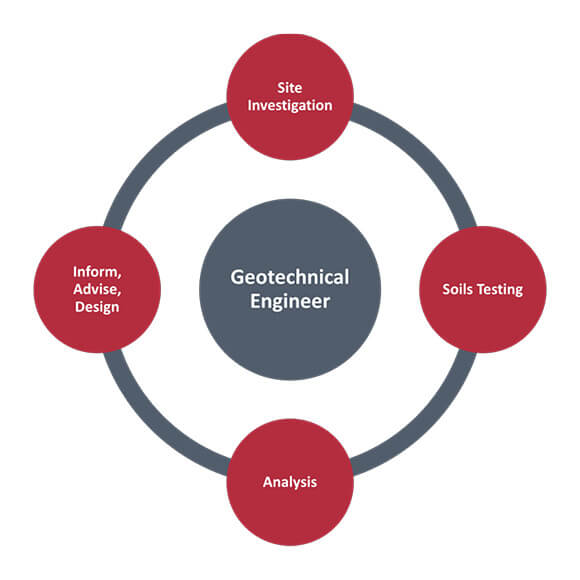Examine This Report about Geotheta
Examine This Report about Geotheta
Blog Article
The Ultimate Guide To Geotheta
Table of ContentsEverything about GeothetaThe Geotheta IdeasGeotheta Can Be Fun For AnyoneThe Greatest Guide To Geotheta
They work together with civil engineers, architectural designers, engineers, and other professionals to integrate geotechnical factors to consider right into the general task style and building and construction process. This requires effective synergy, control, and interaction to make sure that the geotechnical facets straighten with the job objectives and meet governing requirements.Mining & Materials Design: Principles of drilling, infiltration prices, and variables impacting the choice of boring method. Qualities of explosives, shooting systems and blast patterns. Blasting techniques in surface area and underground operations. Unique blowing up strategies at excavation perimeters. Resonance and noise control. Mechanical and continual approaches to fragmentation, consisting of longwall shearing and fullface boring.
Modelling of piece and fragment dimension circulations; comminution as a transfer feature. Comminution modern technology: squashing, grinding, dimension classification. Integrated evaluation of fragmentation and comminution operations. Offered by: Mining & Products Design.
The Geotheta Ideas
Bachelor's degree programs in civil, geotechnical, geological, and environmental design commonly last 4 years and consist of basic education courses in English, social scientific research, and the humanities, in addition to courses in advanced mathematics, architectural geology, and fluid mineralogy. (https://giphy.com/channel/geotheta)
Geotechnical engineering involves the evaluation of the dirt and rock conditions at a specific website, and their ramifications for the growth of that website. As many structures rely upon the ground for assistance, it is without shock that a detailed understanding of the ground conditions, and the viability of foundation systems, are important to the long-term stability and performance of the building or structure.
Specialising in the examination of geological developments and ground behavior, geotechnical engineers execute scientific investigations and screening to understand the effect these geological developments may have on the design and building and construction of building, civil and facilities jobs. This experience is essential for the design and building of buildings, roads, passages, dams, bridges, and water supply and sewer systems.
The geotechnical group at Douglas Allies consistently talk to designers, design engineers, developers, and home builders to make referrals on layout and advancement proposals to guarantee that the built structures are appropriately developed for the ground conditions. As an example, the design of footing systems requires to think about the weight of the structure, the capability of the ground to support that weight together with movement resistances and efficient construction.
The 9-Minute Rule for Geotheta
This task is considerably simplified by the usage of our Douglas Map geospatial system which makes this details easily easily accessible in an easy to make use of internet browser user interface. A geotechnical designer will route the drilling of boreholes and examination pits to gather dirt and other examples, and likewise assess surface functions and ground direct exposures to develop a geotechnical design of the subsurface problems.
Depending upon the task type and ground conditions encountered, research laboratory screening might among various other points evaluate strength, compressibility, reactivity and/or permeability of dirt and rock examples. Hereafter data is accumulated and collated, the results are used for a geotechnical model of the site, which is normally presented as areas throughout the site.

A geotechnical examination naturally can just assess the find out here ground conditions at the locations drilled or excavated. Natural variations in dirt and rock problems can happen throughout a site and in between test areas. It is therefore great method that the geotechnical designer be preserved throughout building of the project to offer on-site verification that the ground conditions come across are regular with the assumptions and advice supplied in the geotechnical examination record.
Some Known Facts About Geotheta.
Geotechnical designers utilize their extensive knowledge of dirt and rock to analyze threat and fix problems on varied framework projectsGeotechnical engineering is a specialist branch of civil engineering which checks out the behaviour of earth products and the application of soil and rock mechanics. Geo Tech Engineering. As a geotechnical designer, you will assess the physical, mechanical and chemical residential or commercial properties of dirt and rock in order to design structures, maintaining frameworks and earthworks
Geotechnical engineering is very closely linked to and overlaps with, both engineering geology and ground design - https://www.openstreetmap.org/user/geotheta. It's possible to specialise in geotechnics or help a geotechnical company but be referred to as an engineering geologist or a ground designer. As a geotechnical designer, you'll need to: build and maintain partnerships with customers and various other experts associated with the site, throughout each projectmaintain security standards on website bear in mind cost effects when you make recommendationsstudy geological maps and airborne photos from a variety of resources and from various time periodsexamine building and construction prepares to see how possible they are based on your understanding of the siteinvestigate dangers or geological dangers for the sitesearch for environmentally sensitive functions, such as landfill start to create factual and expository ground modelsplan area investigationsdrill and evaluate samples of bedrock, dirt, groundwater and extra materials supervise various other experts on sitesolve technological issues as they arise, such as unanticipated structures at drill sitesmonitor problems during and after building and construction to make sure frameworks are secure in the brief and lengthy termadding information accumulated on site to your preliminary researchcreating geotechnical calculations, illustrations, and 2 or three-dimensional computer system models translating the datamaking referrals concerning the suggested usage of the website

Report this page